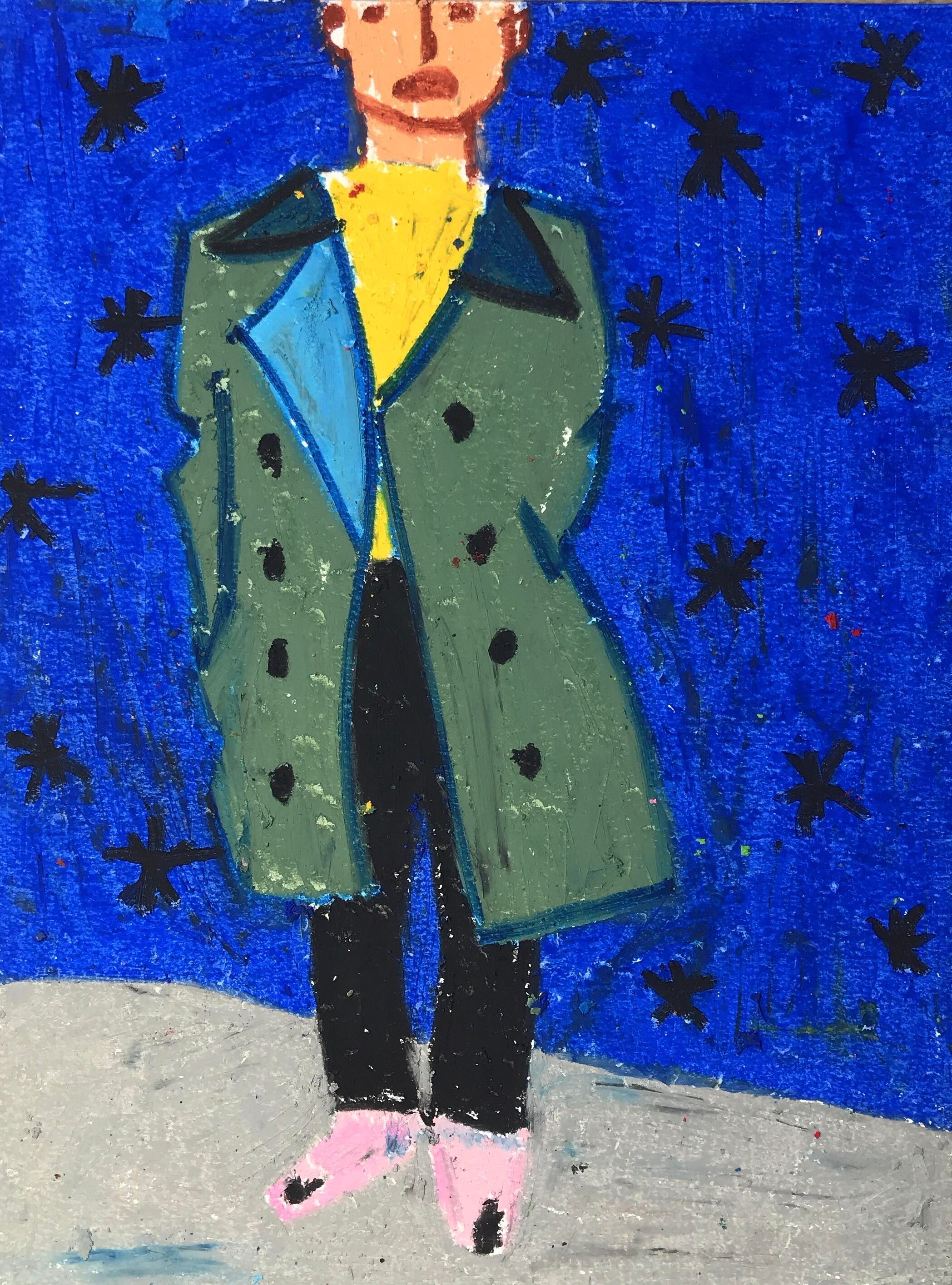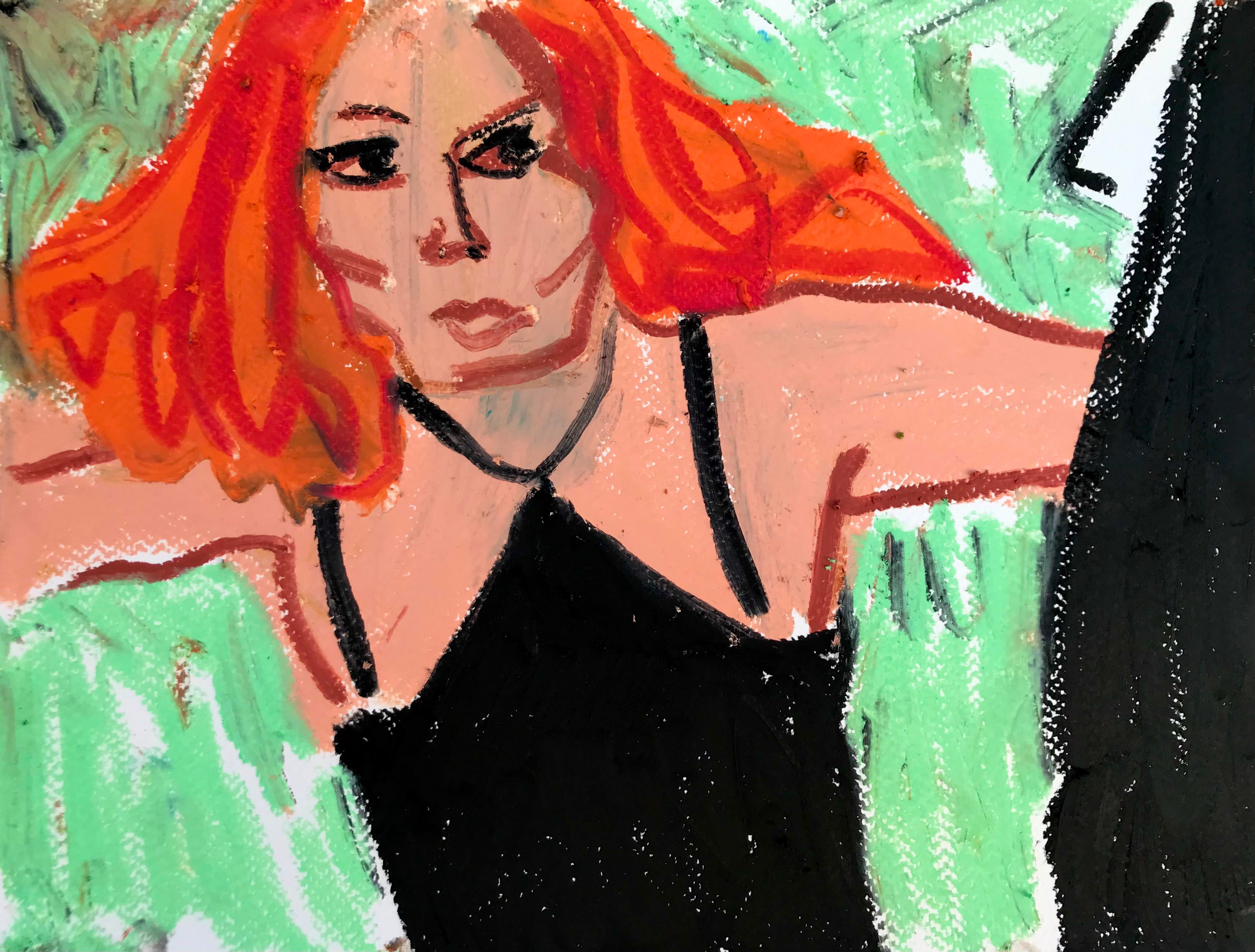When flipping through Brent Cleveland's portfolio, a myriad of colourful figures in different poses jumping out from bright monochromatic backgrounds met my eyes. I was both enchanted and dizzied by his work's inexhaustible variety of life and characters.
This past October, I had the opportunity to sit down with Cleveland to discuss his artistic practice and look through a selection of his drawings. As we sat in McLennan Library on McGill's campus, I was struck by how his bright, creative presence contrasted with the stark academic environment.

Brent Cleveland is a Queer Montreal-based artist specializing in contemporary drawing and painting. He has developed a distinct style of figurative oil pastel drawings focusing on the human form. Hailing from the province of Quebec, Cleveland grew up in the rural Eastern Townships. His love of art was born from his rampant imagination and penchant for daydreaming as a child. He started seriously thinking about becoming an artist when he was a teenager and decided to study fine arts in CEGEP, eventually going on to earn a BFA from the Nova Scotia College of Art Design and an MFA in Studio Arts from Concordia University in Montreal.

Cleveland's figural art pieces depict vignettes of stylized human subjects with angular bodies dressed in vibrantly coloured clothing juxtaposed against contrasting backgrounds. Cleveland portrays these figures in various poses, sometimes with their limbs splayed at odd angles, slouched, or standing straight as if posing for a photograph. He evokes his character's interior landscape through sharp line work and exaggerated proportions. In these pieces, Cleveland's work echoes 20th-century painting techniques such as expressionism, reminiscent of Ernst Ludwig Kirchner and Egon Schiele; however, his artwork is grounded in contemporary discussions of sexuality and the nature of relationships.

Cleveland’s preferred medium is oil pastel on watercolour paper. He explains that this combination gives texture and materiality to the overall composition, as it "speaks more to the body." The thick lines of the oil pastel on porous watercolour paper mimic the texture of skin. In this way, Cleveland's technique creates a complimentary interplay between the piece's medium and its human subject matter.

While he enjoys experimenting with different artistic styles and subjects, Cleveland explains that he always returns to figurative art, believing that human subjects are "the heart or the light source" of his artistic work. Cleveland revealed that he finds inspiration for his figural subjects in magazines, specifically in editorial photographs that capture a certain “essence” or “moment.” He then uses these images as models for the subjects in his paintings, refashioning them into his own distinct creative style and endowing the characters with individual personalities. When crafting these characters’, Cleveland expressed that it is imperative to have a personal sense of connection to the subjects in his paintings. "I'm just trying to get to that feeling— that essence when I'm drawing. — I can't stop until they become someone", he told me emphatically.

There is an especially enigmatic quality to the figures Cleveland creates. His figures convey a sense of familiarity by incorporating pop culture archetypes. Yet, their chic apathy, which manifests in aloof facial expressions and nonchalant poses, keeps the viewer at a distance. At the same time, his figures display a raw sense of vulnerability through their despondent and wistful gazes’ that captivate the viewer.

The duality of these characters also manifests in Cleveland's portrayals of relationships, which he says, attempt to portray the more nuanced elements of Queer relationships and sexuality. In these pieces, Cleveland seeks to capture both platonic and romantic affects within male relationships, explaining, "I think there's something so fascinating about friendships amongst men, or power dynamics between men." These artworks often feature two men averting their gaze from one another or looking forward indifferently, playing on the tensions between love and hate, attraction and repulsion, and trust and jealousy to flesh out the subtleties involved in relationships. His paintings illustrate a more fluid and evolving notion of relationships by depicting the uncomfortable ambiguities of partnerships that defy categorization.

Another area of discussion in our conversation was the differentiation between artwork that has its basis in imagination as opposed to reality. When I asked Cleveland about the vibrant monochromatic backgrounds he often uses, he revealed that these backgrounds remove his figures from the tangible context of the physical world, placing them in a liminal creative space. The fictional plane where his figures exist, he describes, is a product of his rampant imagination that he has had since childhood.

Cleveland emphasized that he has always had a vivid imagination and a knack for storytelling, saying, "I do have a very large imagination. And I have several ideas of universes that exist in my mind." This element of fantasy allows his figures to break outside of the boundaries of the human realm and explore an existence that is not limited by the physical world; as Cleveland expressed, "the world of my characters . . . is not fully grounded in this reality.” For his viewers, the fictional spaces Cleveland creates in his artwork become portals into his universe where his characters exist beyond the borders of the canvas.

As his art evolves, Cleveland seeks to reveal more of his true self as an artist by exploring the creative potential of the figural form to gain a deeper understanding of his dynamic characters and the fantasy world they embody. At the end of our interview, I asked Cleveland, 'how his artistic practice has evolved and where he is going in the future?' Cleveland responded, "I do think my art is getting closer to who I am."





